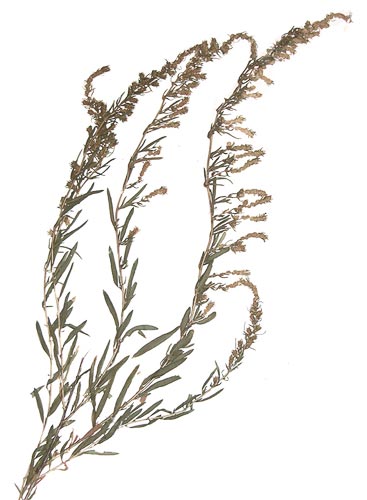Relatives
Eurotia ceratoides (L.) C.A.M. - Horn-like Eurotia.
Taxonomic position.
Family Chenopodiaceae Vent., genus Eurotia Adans.Synonyms.
E. ferruginea Moq., E. pungens Pazij, E. fruticulosa Pazij, Axyris ceratoides L., Krashenninikovia ceratoides Guldenst., Diotis ceratoides L., Ceratospermum papposum Pers., Ceratoides papposa Botsch. et Ikonn., C. latens (J.F. Gmel.) Reveal et Holmgren.Morphology and biology.
Perennial semishrub or small shrub 40-100 cm tall. Entire plant grey with pubescence. Leaves oval, oblong-linear-lanceolate, on short petioles, with entire, slightly revolute margins, 1-veined. Flowers aggregated in inflorescences on branchlet ends. Male flowers with orbicular-ovate, stellately pubescent perianth lobes. Fused bracteoles of female flowers covered with long simple white or reddish hairs, accrescent at fruits, in upper part with divergent, stellately pubescent, free ends. Ovary hairy. Fruit obovoid, about 3 mm long, covered with simple adpressed hairs and sparse stellate ones. Very polymorphic species; different races and ecotypes with very diverse habit, are distinguished within it. Entomophilous. Flowers in July, fruits in September. 2n=36.Distribution.
Black Sea area, Crimea, the Lower Volga and Don, Caucasus, Central Asia, southern West Siberia, also occurs in East Siberia (Angara-Sayans region).Ecology.
In stony, debris, desert steppes, on slopes, at riversides; remarkable for its exceptional adaptation to semidesert conditions.Use and economic value.
Forage plant for steppe, semidesert and high mountain areas. Heavy feeder for sheep and camels. Prospective plant for development of long-term pastures. Recommended to use for soil erosion control. In desert areas is procured for fuel.References:
Grossheim AA. 1949. Manual of plants of Caucasus. Moscow. 747 p. (In Russian).Iljin MM. 1936. Genus Eurotia Adans. In: Shishkin BK., ed. Flora URSS. V.6. Moscow; Leningrad. P.108-109. (In Russian).
Koropachinskiy IYu., Vstovskaya TN. 2002. Woody plants of the Asian part of Russia. Novosibirsk: Publishing House of Siberian Division of the Russian Academy of Science, Branch "Geo". 707 p. (In Russian).
Kurochkina LYa., Osmanova LT., Karibaeva KN. 1986. Forage plants of Kazakhstan deserts. Alma-Ata. 208 p. (In Russian).
Goloskokov VP., ed. 1969. Illustrated manual of the plants of Kazakhstan. V.1. Alma-Ata: Nauka. 644 p. (In Russian).
Bondarenko ON., Nabiev MM. 1972. Manual of plants of Middle Asia. V.3. Tashkent. 268 p. (In Russian).
Sokolov SI., Svjaseva OA., Kubli VA. 1980. Ranges of trees and shrubs of the USSR. V.2. Leningrad: Nauka. Map 6B. (In Russian).
Fedchenko BA., ed. Flora of Turkmenia. V.2(2). Ashkhabad. 218 p. (In Russian).


